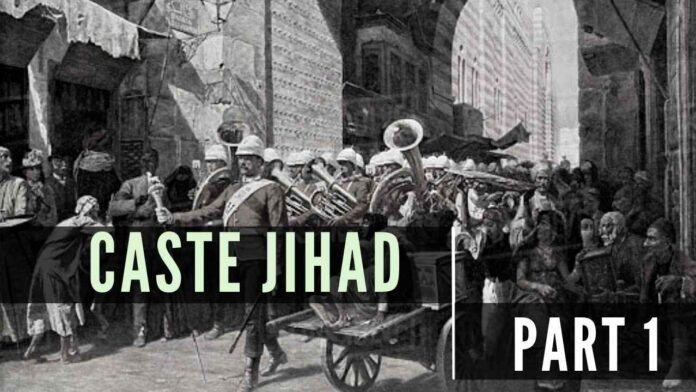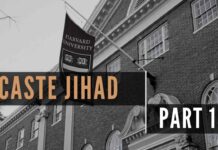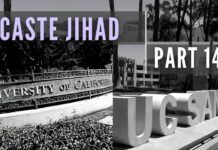
During the 1800s: The birth of “Caste”
The caste system of India has touched all Indians in different ways – the good, the bad, and the ugly depending on where one belongs in the so-called hierarchical caste system as it is perceived if not necessarily practiced today. As I was planning for a series of articles on this issue from the ancient to the present, a just-published article discusses the descendants of the caste issue on U.S. soil. It refers to the most recent developments at the University of California, Davis, neither the first and perhaps nor the last higher education institution to quietly include caste as a protected category in their discrimination policy[1]. While I fully affirm what is said in the recent article, we will return to the regrettable reinvention of the caste system in the U.S. in another article.
It appears that the distorted view of “caste” is a newfound focus among the misguided and self-promoting activists supported by anti-India and anti-Hindu individuals, groups, organizations, and Western media. They have been collaborating in creating a negative narrative that most of us left behind when we started calling the U.S. our home. I for one coming from rural India can and will share my experiences later about the slow but steadily disappearing casteism in villages.
I call the series of my write-ups “Caste-Jihad” by borrowing its aggressive form generally commissioned by a political authority according to the Medieval scholars of Islamic law[2]. In the present context, the colonial authorities were the first “jihadists” imposing their superiority on Indians. This article focuses on the ancient to the colonial India period until about the turn of the 20th century.
The ancient varna system designated Indians in four broad categories- the Brahmin, Kshatriya, Vaishya, and Shudra. These groupings were classified based on the skills set, aptitude, and the needs for a functional society. For example, the Brahmins were meant to be the most educated and knowledgeable of Sanatan Dharma scriptures, rituals, traditions and served as teachers and gurus for other varnas.
To the best of my understanding, people could move from one varna to another if their skill set, aptitude, and abilities qualified them to do so. For example, a Brahmin could be engaged in business/ trade typically expected of a Vaishya or a Shudra could become a king/ warrior typically done by a Kshatriya. For example, the Nanda Dynasty between the 5th and 4th century BC was founded by the son of a barber which in the varna system will be a Shudra and the Gupta dynasty which belonged to Vaishya in contrast to being Kshatriya. Not surprisingly, the Mahabharata and Ramayana, the ancient and most revered epics of all times, were composed by the sages who will be classified Shudras in the varna system and “Dalits” in today’s most controversial and contentious caste system.
During the white colonialism in India in the 17th century, the word “casta” of Spanish and Portuguese origin was anglicized as “caste” meaning the “race, lineage, or breed.” The colonial power had the desire to understand the differences and similarities among people in India who had different religions and characteristics beyond the categories of the varna system. In many cases, Indians’ identity overlapped in race, language, and /or religion. For example, the Britishers were bewildered that Hindus and Muslims spoke the same language and had similar racial characteristics. Did they not realize that most Muslims in India at the time converted from Hindus during the Mughal period?
As I reviewed the British Raj history, it is my contention that Thomas Macaulay, a civil servant from 1834-1838, may be the first British jihadist. He convinced the then Governor-General to adopt English as the medium of instruction from the sixth year of schooling onwards[3], rather than Sanskrit or Arabic (Urdu)[4]. That was the beginning of the end of the dominance of Indian languages. What is termed as ‘confident’ Macaulay declaring that a “single shelf of good European literature” was worth the entire “native literature of India and Arabia[5],” is, in my view, an ill-conceived jihad against India’s literature, languages, and by extension the ancient culture.
Macaulay’s firm conviction that the European curriculum and culture were superior to that of India has had a lasting impact on colonial attitudes and the policy of funding education only in English. He pronounced that to offer any type of assistance for Hindu schools, would be, “high treason against humanity and civilization.” What is it if not the modern-day jihad practiced by the hard-core Islamists? Growing up I thought that the English language was an admirable gift by the colonial empire to Indians for successful navigation of the global world but I must confess I did not know about Macaulay’s arrogance and assertion of superiority. I now note that he was really the British jihadist of his time.
I cannot believe that Macaulay’s “Minute on Indian Education” delivered in 1835 stated[6], “ …We must at present do our best to form a class who may be interpreters between us and the millions whom we govern; a class of persons, Indian in blood and colour, but English in taste, in opinions, in morals, and in intellect. To that class we may leave it to refine the vernacular dialects of the country, to enrich those dialects with terms of science borrowed from the Western nomenclature, and to render them by degrees fit vehicles for conveying knowledge to the great mass of the population.” Even long after his return to England, his successors continued to practice and enforce the colonial attitude, arrogance, and sense of superiority. Note that he essentially divided India in a “class” system by way of dismantling India’s education system and imposing Western curriculum and English as a medium of instruction.
It was the 1857 revolt by Indians against the British Raj, the need for deeper knowledge about the manners and social constructs of the former was recognized by the latter for continuing to rule over India[7]. It was then that the colonial power decided not only to hold census but also translate ancient scriptures under the editorship of Max Mueller[8]. It was an attempt to consolidate the body of knowledge to understand societal values, customs, and culture. It was also critical for the colonial power to offer legitimacy to their style of administration and the decisions they made. In fact, the aggressive form of jihad got further boost with Max Muller who once said that the second conquest of India should be a conquest by education. He created distorted translations of India’s scriptures like the vedas and carried on the reforms in Hinduism to superimpose Christian values on it. First Macaulay and then Muller planned things so insidiously that the ancient Gurukul system was abandoned and an English curriculum devoid of India’s languages, cultural, and civilizational ethos was firmly imposed[9].
The mutiny of 1857 led to the reorganization of the army on caste and ethnic lines to the extent that certain castes and tribes were declared criminal[7]. Then a series of censuses were carried out and the Colonial jihad continued when the colonizers felt it necessary to devise a system under the banner of anthropological understanding but with the intent of dividing Indians into categories (the caste-system) which could be helpful in governance/ reign of India. Consequently, the colonial mindset introduced the caste with the religious categories to be a part of the very first census of 1872. In the beginning, caste was equated with the class which the colonial state incorporated caste and religious categories. This census, however, was neither synchronous nor covered the entire colonial territory. In fact, the first synchronous census began from the census of 1881.
It should be noted that the census was the British empire’s instrument and a political phenomenon that included mutually exclusive ethnic, religious, racial, and caste groups and divided people by geographical boundary. During this period, I assert that the colonizers commissioned jihad and classified Indians in a convoluted and conflicted caste or equivalent word Jati which included as many as 3000 such groups or communities. Jati was like the brotherhood (biradari) with lots of prescriptions and prohibitions like who can marry whom, from who its members can accept food and water, and showing major loyalty to their own jati at almost all times. It should be mentioned, however, that the caste system was not limited to only Hindus but even the Muslims and Christians in India had their own “caste” system.
The next article in this series will review the continuation of jihad of the caste system in the 1900s which the colonizers kept expanding in even more convoluted ways. It got further politicized with two prominent Indians, Ambedkar, and Gandhi, being of a different mindset to protect the “Dalits,” the newest category that did not quite exist in the ancient varna system.
To be continued…
Note:
1. Text in Blue points to additional data on the topic.
2. The views expressed here are those of the author and do not necessarily represent or reflect the views of PGurus.
References:
[1] SF Chronicle pushes bias against Hindus with its recent article on “Caste” and UC Davis – Nov 29, 2021, PGurus.com
[2] So, what really is jihad? – Jun 20, 2019, The Conversation
[3] New World Encyclopedia – England – New World Encyclopedia
[4] New World Encyclopedia – Sanskrit – New World Encyclopedia
[5] New World Encyclopedia – Arabian Peninsula – New World Encyclopedia
[6] New World Encyclopedia – Thomas Babington Macaulay – New World Encyclopedia
[7] Census, Politics and Construction of Identities in India – Research Gate
[8] Remember Max Muller: The man employed to create a distorted translation of the Vedas – Dec 06, 2016, India Today
[9] Max Muller & His Unwritten Deceit – Oct 24, 2020, Kreately
PGurus is now on Telegram. Click here to join our channel and stay updated with all the latest news and views
For all the latest updates, download PGurus App.
- Education and election in Bharat: Race to the top - April 16, 2024
- Kejriwal: “An Insignificant Man” or a corrupt politician with impending prison term - March 24, 2024
- Bharat’s general elections and the Model Code of Conduct - March 22, 2024










